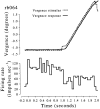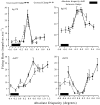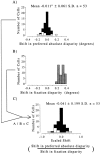Binocular neurons in V1 of awake monkeys are selective for absolute, not relative, disparity
- PMID: 10377367
- PMCID: PMC6782336
- DOI: 10.1523/JNEUROSCI.19-13-05602.1999
Binocular neurons in V1 of awake monkeys are selective for absolute, not relative, disparity
Abstract
Most neurophysiological accounts of disparity selectivity in neurons of the primary visual cortex (V1) imply that they are selective for absolute retinal disparities. By contrast, a number of psychophysical observations indicate that relative disparities play a more important role in depth perception. During recordings from disparity selective neurons in area V1 of awake behaving monkeys, we used a disparity feedback loop () to add controlled amounts of absolute disparity to a display containing both absolute and relative disparities. This manipulation changed the absolute disparity of all the visible features in the display but left unchanged the relative disparities signalled by these features. The addition of absolute disparities produced clear changes in the neural responses to unchanged external stimuli, which were well predicted by the measured change in absolute disparity: in 45/53 cases, the neuron maintained a consistent firing pattern with respect to absolute disparity so that the manipulation created no significant change in the absolute disparity preferred by the neuron. No neuron in V1 maintained a consistent relationship with relative disparity. We conclude that the relative disparity signals used in primate depth perception are constructed outside area V1.
Figures

















Similar articles
-
Effect of interocular delay on disparity-selective v1 neurons: relationship to stereoacuity and the pulfrich effect.J Neurophysiol. 2005 Aug;94(2):1541-53. doi: 10.1152/jn.01177.2004. Epub 2005 Mar 23. J Neurophysiol. 2005. PMID: 15788521 Free PMC article.
-
A specialization for relative disparity in V2.Nat Neurosci. 2002 May;5(5):472-8. doi: 10.1038/nn837. Nat Neurosci. 2002. PMID: 11967544
-
Responses of primary visual cortical neurons to binocular disparity without depth perception.Nature. 1997 Sep 18;389(6648):280-3. doi: 10.1038/38487. Nature. 1997. PMID: 9305841
-
Mechanisms of stereopsis in monkey visual cortex.Cereb Cortex. 1995 May-Jun;5(3):193-204. doi: 10.1093/cercor/5.3.193. Cereb Cortex. 1995. PMID: 7613075 Review.
-
Neuronal Representation of 3-D Space in the Primary Visual Cortex and Control of Eye Movements.Perception. 2015;44(8-9):995-1006. doi: 10.1177/0301006615594930. Epub 2015 Aug 14. Perception. 2015. PMID: 26562914 Review.
Cited by
-
Linking neural representation to function in stereoscopic depth perception: roles of the middle temporal area in coarse versus fine disparity discrimination.J Neurosci. 2006 Jun 21;26(25):6791-802. doi: 10.1523/JNEUROSCI.5435-05.2006. J Neurosci. 2006. PMID: 16793886 Free PMC article.
-
Retinal versus physical stimulus size as determinants of visual perception in simultanagnosia.Neuropsychologia. 2010 May;48(6):1677-82. doi: 10.1016/j.neuropsychologia.2010.02.013. Epub 2010 Feb 16. Neuropsychologia. 2010. PMID: 20170667 Free PMC article.
-
Local disparity not perceived depth is signaled by binocular neurons in cortical area V1 of the Macaque.J Neurosci. 2000 Jun 15;20(12):4758-67. doi: 10.1523/JNEUROSCI.20-12-04758.2000. J Neurosci. 2000. PMID: 10844045 Free PMC article.
-
Optimal Stereoacuity Reveals More Than Critical Time in Patients With Intermittent Exotropia.Front Neurosci. 2020 Feb 18;14:133. doi: 10.3389/fnins.2020.00133. eCollection 2020. Front Neurosci. 2020. PMID: 32132901 Free PMC article.
-
The representation of visual depth perception based on the plenoptic function in the retina and its neural computation in visual cortex V1.BMC Neurosci. 2014 Apr 23;15:50. doi: 10.1186/1471-2202-15-50. BMC Neurosci. 2014. PMID: 24755246 Free PMC article.
References
-
- Bishop PO, Henry GH. Spatial vision. Annu Rev Psychol. 1971;22:119–160. - PubMed
-
- Brookes A, Stevens KA. The analogy between stereo depth and brightness. Perception. 1989;18:601–614. - PubMed
-
- Cumming BG, Judge SJ. Disparity-induced and blur-induced convergence eye movement and accommodation in the monkey. J Neurophysiol. 1986;55:896–914. - PubMed
Publication types
MeSH terms
Grants and funding
LinkOut - more resources
Full Text Sources
